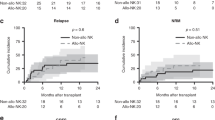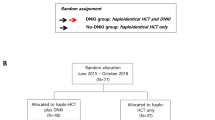Abstract
Natural killer (NK) cells are the first lymphocytes to recover after allogeneic stem cell transplantation (SCT) and can exert powerful graft-versus-leukemia (GVL) effects determining transplant outcome. Conditions governing NK cell alloreactivity and the role of NK recovery in sibling SCT are not well defined. NK cells on day 30 post-transplant (NK30) were measured in 54 SCT recipients with leukemia and donor and recipient killer immunoglobulin-like receptor (KIR) genotype determined. In univariate analysis, donor KIR genes 2DL5A, 2DS1, 3DS1 (positive in 46%) and higher numbers of inhibitory donor KIR correlated with higher NK30 counts and were associated with improved transplant outcome. NK30 counts also correlated directly with the transplant CD34 cell dose and inversely with the CD3+ cell dose. In multivariate analysis, the NK30 emerged as the single independent determinant of transplant outcome. Patients with NK30 >150/μl had less relapse (HR 18.3, P=0.039), acute graft-versus-host disease (HR 3.2, P=0.03), non-relapse mortality (HR 10.7, P=0.028) and improved survival (HR 11.4, P=0.03). Results suggest that T cell-depleted SCT might be improved and the GVL effect enhanced by selecting donors with favorable KIR genotype, and by optimizing CD34 and CD3 doses.
This is a preview of subscription content, access via your institution
Access options
Subscribe to this journal
Receive 12 print issues and online access
$259.00 per year
only $21.58 per issue
Buy this article
- Purchase on Springer Link
- Instant access to full article PDF
Prices may be subject to local taxes which are calculated during checkout


Similar content being viewed by others
References
Ruggeri L, Capanni M, Casucci M, Volpi I, Tosti A, Perruccio K et al. Role of natural killer cell alloreactivity in HLA-mismatched hematopoietic stem cell transplantation. Blood 1999; 94: 333–339.
Ruggeri L, Capanni M, Urbani E, Perruccio K, Shlomchik WD, Tosti A et al. Effectiveness of donor natural killer cell alloreactivity in mismatched hematopoietic transplants. Science 2002; 295: 2097–2100.
Savani BN, Rezvani K, Mielke S, Montero A, Kurlander R, Carter CS et al. Factors associated with early molecular remission after T cell-depleted allogeneic stem cell transplantation for chronic myelogenous leukemia. Blood 2006; 107: 1688–1695.
Zeis M, Uharek L, Glass B, Gaska T, Steinmann J, Gassmann W et al. Allogeneic NK cells as potent antileukemic effector cells after allogeneic bone marrow transplantation in mice. Transplantation 1995; 59: 1734–1736.
Hauch M, Gazzola MV, Small T, Bordignon C, Barnett L, Cunningham I et al. Anti-leukemia potential of interleukin-2 activated natural killer cells after bone marrow transplantation for chronic myelogenous leukemia. Blood 1990; 75: 2250–2262.
Murphy WJ, Reynolds CW, Tiberghien P, Longo DL . Natural killer cells and bone marrow transplantation. J Natl Cancer Inst 1993; 85: 1475–1482.
Brooks AG, Boyington JC, Sun PD . Natural killer cell recognition of HLA class I molecules. Rev Immunogenet 2000; 2: 433–448.
Boyington JC, Motyka SA, Schuck P, Brooks AG, Sun PD . Crystal structure of an NK cell immunoglobulin-like receptor in complex with its class I MHC ligand. Nature 2000; 405: 537–543.
Ruggeri L, Mancusi A, Burchielli E, Aversa F, Martelli MF, Velardi A . Natural killer cell alloreactivity and haplo-identical hematopoietic transplantation. Cytotherapy 2006; 8: 554–558.
Jiang YZ, Barrett AJ, Goldman JM, Mavroudis DA . Association of natural killer cell immune recovery with a graft-versus-leukemia effect independent of graft-versus-host disease following allogeneic bone marrow transplantation. Ann Hematol 1997; 74: 1–6.
Mackinnon S, Bungey J, Chase A, Paulsen W, Hows JM, Goldman JM . Origin and function of adherent lymphokine activated killer cells in patients with chronic myeloid leukaemia who relapse following bone marrow transplantation. Br J Haematol 1991; 77: 60–65.
Sconocchia G, Lau M, Provenzano M, Rezvani K, Wongsena W, Fujiwara H et al. The antileukemia effect of HLA-matched NK and NK-T cells in chronic myelogenous leukemia involves NKG2D-target-cell interactions. Blood 2005; 106: 3666–3672.
Sconocchia G, del PD, Barrett AJ . Non-classical antileukemia activity of early recovering NK cells after induction chemotherapy and HLA-identical stem cell transplantation in myeloid leukemias. Leukemia 2006; 20: 1632–1633.
Cook MA, Milligan DW, Fegan CD, Darbyshire PJ, Mahendra P, Craddock CF et al. The impact of donor KIR and patient HLA-C genotypes on outcome following HLA-identical sibling hematopoietic stem cell transplantation for myeloid leukemia. Blood 2004; 103: 1521–1526.
Hsu KC, Keever-Taylor CA, Wilton A, Pinto C, Heller G, Arkun K et al. Improved outcome in HLA-identical sibling hematopoietic stem-cell transplantation for acute myelogenous leukemia predicted by KIR and HLA genotypes. Blood 2005; 105: 4878–4884.
De SD, Bishara A, Witt CS, Nagler A, Brautbar C, Slavin S et al. Natural killer cell HLA-C epitopes and killer cell immunoglobulin-like receptors both influence outcome of mismatched unrelated donor bone marrow transplants. Tissue Antigens 2005; 65: 519–528.
Leung W, Iyengar R, Triplett B, Turner V, Behm FG, Holladay MS et al. Comparison of killer Ig-like receptor genotyping and phenotyping for selection of allogeneic blood stem cell donors. J Immunol 2005; 174: 6540–6545.
Bishara A, De SD, Witt CC, Brautbar C, Christiansen FT, Or R et al. The beneficial role of inhibitory KIR genes of HLA class I NK epitopes in haploidentically mismatched stem cell allografts may be masked by residual donor-alloreactive T cells causing GVHD. Tissue Antigens 2004; 63: 204–211.
Chen C, Busson M, Rocha V, Appert ML, Lepage V, Dulphy N et al. Activating KIR genes are associated with CMV reactivation and survival after non-T-cell depleted HLA-identical sibling bone marrow transplantation for malignant disorders. Bone Marrow Transplant 2006; 38: 437–444.
Verheyden S, Schots R, Duquet W, Demanet C . A defined donor activating natural killer cell receptor genotype protects against leukemic relapse after related HLA-identical hematopoietic stem cell transplantation. Leukemia 2005; 19: 1446–1451.
Montero A, Savani BN, Shenoy A, Read EJ, Carter CS, Leitman SF et al. T cell depleted peripheral blood stem cell allotransplantation with T cell add back for patients with hematological malignancies: effect of chronic GVHD on outcome. Biol Blood Marrow Transplant 2006; 12: 1318–1325.
Dupont B, Hsu KC . Inhibitory killer Ig-like receptor genes and human leukocyte antigen class I ligands in haematopoietic stem cell transplantation. Curr Opin Immunol 2004; 16: 634–643.
Gagne K, Brizard G, Gueglio B, Milpied N, Herry P, Bonneville F et al. Relevance of KIR gene polymorphisms in bone marrow transplantation outcome. Hum Immunol 2002; 63: 271–280.
Witt CS, Dewing C, Sayer DC, Uhrberg M, Parham P, Christiansen FT . Population frequencies and putative haplotypes of the killer cell immunoglobulin-like receptor sequences and evidence for recombination. Transplantation 1999; 68: 1784–1789.
Crum KA, Logue SE, Curran MD, Middleton D . Development of a PCR-SSOP approach capable of defining the natural killer cell inhibitory receptor (KIR) gene sequence repertoires. Tissue Antigens 2000; 56: 313–326.
Cooley S, McCullar V, Wangen R, Bergemann TL, Spellman S, Weisdorf DJ et al. KIR reconstitution is altered by T cells in the graft and correlates with clinical outcomes after unrelated donor transplantation. Blood 2005; 106: 4370–4376.
Sun JY, Dagis A, Gaidulis L, Miller MM, Rodriguez R, Parker P et al. Detrimental effect of natural killer cell alloreactivity in T-replete hematopoietic cell transplantation (HCT) for leukemia patients. Biol Blood Marrow Transplant 2007; 13: 197–205.
Singh AK, Savani BN, Albert PS, Barrett AJ . Efficacy of CD34+ stem cell dose in patients undergoing allogeneic peripheral blood stem cell transplantation after total body irradiation. Biol Blood Marrow Transplant 2007; 13: 339–344.
Ringden O, Barrett AJ, Zhang MJ, Loberiza FR, Bolwell BJ, Cairo MS et al. Decreased treatment failure in recipients of HLA-identical bone marrow or peripheral blood stem cell transplants with high CD34 cell doses. Br J Haematol 2003; 121: 874–885.
Warren HS . Using carboxyfluorescein diacetate succinimidyl ester to monitor human NK cell division: analysis of the effect of activating and inhibitory class I MHC receptors. Immunol Cell Biol 1999; 77: 544–551.
Author information
Authors and Affiliations
Corresponding author
Rights and permissions
About this article
Cite this article
Savani, B., Mielke, S., Adams, S. et al. Rapid natural killer cell recovery determines outcome after T-cell-depleted HLA-identical stem cell transplantation in patients with myeloid leukemias but not with acute lymphoblastic leukemia. Leukemia 21, 2145–2152 (2007). https://doi.org/10.1038/sj.leu.2404892
Received:
Revised:
Accepted:
Published:
Issue Date:
DOI: https://doi.org/10.1038/sj.leu.2404892
Keywords
This article is cited by
-
Relapse of acute myeloid leukemia after allogeneic stem cell transplantation: immune escape mechanisms and current implications for therapy
Molecular Cancer (2023)
-
Natural killer cell therapy for hematologic malignancies: successes, challenges, and the future
Stem Cell Research & Therapy (2021)
-
Clinically applicable CD34+-derived blood dendritic cell subsets exhibit key subset-specific features and potently boost anti-tumor T and NK cell responses
Cancer Immunology, Immunotherapy (2021)
-
Natural killer cell-based immunotherapy for acute myeloid leukemia
Journal of Hematology & Oncology (2020)
-
The European Society for Blood and Marrow Transplantation (EBMT) consensus recommendations for donor selection in haploidentical hematopoietic cell transplantation
Bone Marrow Transplantation (2020)



